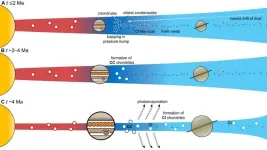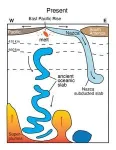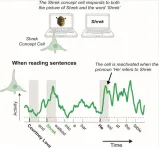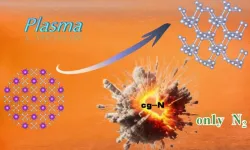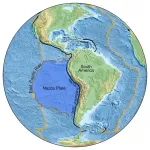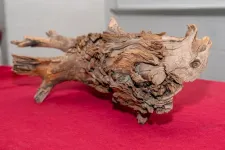(Press-News.org) In December 2020 the space probe Hayabusa 2 brought samples of asteroid Ryugu back to Earth. Since then, the few grams of material have been through quite a lot. After initial examinations in Japan, some of the tiny, jet-black grains traveled to research facilities around the world. There they were measured, weighed, chemically analyzed and exposed to infrared, X-ray and synchroton radiation, among other things. At the MPS, researchers examine the ratios of certain metal isotopes in the samples, as in the current study. Scientists refer to isotopes as variants of the same element that differ only in the number of neutrons in the nucleus. Investigations of this kind can help to understand where in the Solar System Ryugu was formed.
Ryugu's journey through the Solar System
Ryugu is a near-Earth asteroid: Its orbit around the Sun crosses that of Earth (without risk of collision). However, researchers assume that, like other near-Earth asteroids, Ryugu is not native to the inner Solar System, but travelled there from the asteroid belt located between the orbits of Mars and Jupiter. The actual birthplaces of the asteroid belt population are probably even further away from the Sun, outside the orbit of Jupiter.
Ryugu's “family relations” can help shed light on its origin and further evolution. To what degree does Ryugu resemble the representatives of well-known classes of meteorites? These are fragments of asteroids that have made their way from space to Earth. Investigations in recent years have yielded a surprise: Ryugu fits into the large crowd of carbon-rich meteorites, the carbonaceous chondrites, as expected. However, detailed studies of its composition assign it to a rare group: the so-called CI chondrites. These are also known as Ivuna-type chondrites, named after the Tanzanian location where their best-known representative was found. In addition to the Ivuna chondrite itself, only eight others of these exotic specimens have been discovered to date. As their chemical composition is similar to that of the Sun, they are considered to be particularly pristine material that was formed at the outermost edge of the Solar System. “So far, we had assumed that Ryugu's place of origin is also outside Saturn's orbit,” explains MPS scientist Dr. Timo Hopp, co-author of the current study, who has already led earlier investigations into Ryugu's isotopic composition.
The latest analyses by the Göttingen scientists now paint a different picture. For the first time, the team has investigated the ratios of nickel isotopes in four samples of the asteroid Ryugu and six samples of carbonaceous chondrites. The results confirm the close relationship between Ryugu and the CI chondrites. However, the idea of a common birthplace at the edge of the Solar System is no longer compelling.
A missing ingredient
What had happened? Until now, researchers had understood carbonaceous chondrites as mixtures of three “ingredients” that can even be seen with the naked eye in cross-sections. Embedded in fine-grained rock, round, millimeter-sized inclusions as well as smaller, irregularly shaped inclusions are densely packed together. The irregular inclusions are the first material to have condensed into solid clumps in the hot gas disk that once orbited the Sun. The round silicate-rich chondrules formed later. Until now, researchers have attributed differences in the isotopic composition between CI chondrites and other groups of carbonaceous chondrites to different mixing ratios of these three ingredients. CI chondrites, for example, consist predominantly of fine-grained rock, while their siblings are significantly richer in inclusions. However, as the team describes in the current publication, the results of the nickel measurements do not fit into this scheme.
The researchers' calculations now show that their measurements can only be explained by a fourth ingredient: tiny iron-nickel grains, which must also have accumulated during the formation of the asteroids. In the case of Ryugu and the CI chondrites, this process must have been particularly efficient. “Completely different processes must have been at work in the formation of Ryugu and the CI chondrites on the one hand and the other groups of carbonaceous chondrites on the other,” says Fridolin Spitzer from the MPS, first author of the new study, summarizing the basic idea.
According to the researchers, the first carbonaceous chondrites began to form around two million years after the formation of the Solar System. Attracted by the gravitational force of the still young Sun, dust and the first solid clumps made their way from the outer edge of the gas and dust disk into the inner Solar System, but encountered an obstacle along the way: the newly forming Jupiter. Outside its orbit, the heavier and larger clumps in particular accumulated - and thus grew into carbonaceous chondrites with their many inclusions. Towards the end of this development, after around two million years, another process gained the upper hand: under the influence of the Sun, the original gas gradually evaporated outside Jupiter's orbit leading to the accumulation of primarily dust and iron-nickel grains. This led to the birth of the CI chondrites.
“The results surprised us very much. We had to completely rethink - not only with regard to Ryugu, but also with regard to the entire group of CI chondrites,” says Dr. Christoph Burkhard from the MPS. The CI chondrites no longer appear as distant, somewhat exotic relatives of the other carbonaceous chondrites from the outermost edge of the Solar System, but rather as younger siblings that may have formed in the same region, but through a different process and later. “The current study shows how crucial laboratory investigations can be in deciphering the formation history of our Solar System,” says Prof. Dr. Thorsten Kleine, Director of the Department of Planetary Sciences at the MPS and co-author of the study.
END
A new birthplace for asteroid Ryugu
Samples of asteroid Ryugu have once again caused a surprise - and call into question previous ideas about the formation of carbon-rich asteroids.
2024-09-27
ELSE PRESS RELEASES FROM THIS DATE:
How are pronouns processed in the memory-region of our brain?
2024-09-27
A new study shows how individual brain cells in the hippocampus respond to pronouns. “This may help us unravel how we remember what we read.”
Read the following sentence: “Donald Trump and Kamala Harris walked into the bar, she sat down at a table.” We all immediately know that it was Kamala who sat at the table, not Donald. Pronouns like “she” help us to understand language, but pronouns can have multiple meanings. Depending on the context, we understand who the pronoun is referring to. But ...
Researchers synthesize high-energy-density cubic gauche nitrogen at atmospheric pressure
2024-09-27
Recently, a research group led by Prof. WANG Xianlong from the Hefei Institutes of Physical Science of the Chinese Academy of Sciences, successfully synthesized high-energy-density materials cubic gauche nitrogen (cg-N) at atmospheric pressure by treating potassium azide (KN3) using the plasma-enhanced chemical vapour deposition technique (PECVD).
The research results were published in Science Advances.
Cg-N is a pure nitrogen material consisting of nitrogen atoms bonded by N-N single bonds, resembling the structure of diamond. It has attracted attention because it has a high-energy-density and produces only nitrogen gas when it decomposes. ...
Ancient sunken seafloor reveals earth’s deep secrets
2024-09-27
University of Maryland scientists uncovered evidence of an ancient seafloor that sank deep into Earth during the age of dinosaurs, challenging existing theories about Earth’s interior structure. Located in the East Pacific Rise (a tectonic plate boundary on the floor of the southeastern Pacific Ocean), this previously unstudied patch of seafloor sheds new light on the inner workings of our planet and how its surface has changed over millions of years. The team’s findings were published in the journal Science Advances on September 27, 2024.
Led by geology postdoctoral researcher Jingchuan Wang, the team used innovative seismic imaging techniques to ...
Automatic speech recognition learned to understand people with Parkinson’s disease — by listening to them
2024-09-27
As Mark Hasegawa-Johnson combed through data from his latest project, he was pleasantly surprised to uncover a recipe for Eggs Florentine. Sifting through hundreds of hours of recorded speech will unearth a treasure or two, he said.
Hasegawa-Johnson leads the Speech Accessibility Project, an initiative at the University of Illinois Urbana-Champaign to make voice recognition devices more useful for people with speech disabilities.
In the project’s first published study, researchers asked an automatic ...
Addressing global water security challenges: New study reveals investment opportunities and readiness levels
2024-09-27
NEW YORK, September 27, 2024 – Water scarcity, pollution, and the burden of waterborne diseases are urgent issues threatening global health and security. A recently published study in the journal Global Environmental Change highlights the pressing need for innovative economic strategies to bolster water security investments, focusing on the “enabling environment” that influences regional readiness for new business solutions.
Initiated and led by researchers at the Advanced Science Research Center at the CUNY Graduate Center (CUNY ASRC), ...
Commonly used drug could transform treatment of rare muscle disorder
2024-09-27
The study, published in Lancet Neurology, detailed the “head-to-head” trial implemented by the researchers to test two drugs, mexiletine and lamotrigine, on people with the condition.
The trial, which was conducted at the UCL Queen Square Multidisciplinary Centre for Neuromuscular Diseases and the National Hospital for Neurology and Neurosurgery, UCLH, involved 60 adults with confirmed non-dystrophic myotonia.
Patients were randomly assigned to receive either mexiletine for eight weeks followed by lamotrigine for eight weeks, or the reverse order, with a seven-day ...
Michael Frumovitz, M.D., posthumously honored with Julie and Ben Rogers Award for Excellence
2024-09-27
HOUSTON ― The University of Texas MD Anderson Cancer Center has posthumously awarded Michael Frumovitz, M.D., with the Julie and Ben Rogers Award for Excellence in Patient Care. The annual award recognizes employees who consistently demonstrate excellence in their work and dedication to MD Anderson’s mission to end cancer. The award’s focus rotates among the areas of patient care, research, education, prevention and administration, with this year’s award focusing on patient care.
Frumovitz dedicated more than 20 years of service to MD Anderson, most recently as chief patient experience officer and professor in Gynecologic ...
NIH grant supports research to discover better treatments for heart failure
2024-09-27
A University of Arizona College of Medicine – Phoenix researcher was recently awarded a $1.9 million National Institutes of Health grant to study the molecular mechanisms of how dilated cardiomyopathy progresses to heart failure, which could eventually lead to better preventive and treatment options for heart failure.
Heart failure is inextricably linked with dilated cardiomyopathy, or DCM, a disease characterized by the progressive enlargement of the heart and reduced contractility reflected by reduced ejection fraction. ...
Clinical cancer research in the US is increasingly dominated by pharmaceutical industry sponsors, study finds
2024-09-27
Clinical cancer research in the U.S. is increasingly dominated by pharmaceutical industry sponsors, study finds
Study underscores need for increased investment in federally funded cancer clinical trials
SEATTLE – September 27, 2024 – Researchers at Fred Hutch Cancer Center identified a substantial increase over the past decade in the proportion of patients with cancer in the U.S. who participate in pharmaceutical industry sponsored clinical trials compared to those conducted with federal government support. Published in The Journal of Clinical Oncology and presented at the ASCO Quality Care Symposium, these findings reveal trends of underinvestment in federally ...
Discovery of 3,775-year-old preserved log supports ‘wood vaulting’ as a climate solution
2024-09-27
A new study published in the journal Science suggests that an ordinary old log could help refine strategies to tackle climate change.
A team of researchers led by University of Maryland Atmospheric and Oceanic Science Professor Ning Zeng analyzed a 3,775-year-old log and the soil it was excavated from. Their analysis, published on September 27, 2024, revealed that the log had lost less than 5% carbon dioxide from its original state thanks to the low-permeability clay soil that covered it.
“The wood is nice and solid—you could probably make a piece of furniture out of it,” Zeng noted.
Understanding the ...
LAST 30 PRESS RELEASES:
Three UH Rainbow Babies & Children’s faculty elected to prestigious American Pediatric Society
Tunnel resilience models unveiled to aid post-earthquake recovery
Satellite communication systems: the future of 5G/6G connectivity
Space computing power networks: a new frontier for satellite technologies
Experiments advance potential of protein that makes hydrogen sulfide as a therapeutic target for Alzheimer’s disease
Examining private equity’s role in fertility care
Current Molecular Pharmacology achieves a landmark: real-time CiteScore advances to 7.2
Skeletal muscle epigenetic clocks developed using postmortem tissue from an Asian population
Estimating unemployment rates with social media data
Climate policies can backfire by eroding “green” values, study finds
Too much screen time too soon? A*STAR study links infant screen exposure to brain changes and teen anxiety
Global psychiatry mourns Professor Dan Stein, visionary who transformed mental health science across Africa and beyond
KIST develops eco-friendly palladium recovery technology to safeguard resource security
Statins significantly reduce mortality risk for adults with diabetes, regardless of cardiovascular risk
Brain immune cells may drive more damage in females than males with Alzheimer’s
Evidence-based recommendations empower clinicians to manage epilepsy in pregnancy
Fungus turns bark beetles’ defenses against them
There are new antivirals being tested for herpesviruses. Scientists now know how they work
CDI scientist, colleagues author review of global burden of fungus Candida auris
How does stroke influence speech comprehension?
B cells transiently unlock their plasticity, risking lymphoma development
Advanced AI dodel predicts spoken language outcomes in deaf children after cochlear implants
Multimodal imaging-based cerebral blood flow prediction model development in simulated microgravity
Accelerated streaming subgraph matching framework is faster, more robust, and scalable
Gestational diabetes rose every year in the US since 2016
OHSU researchers find breast cancer drug boosts leukemia treatment
Fear and medical misinformation regarding risk of progression or recurrence among patients with breast cancer
Glucagonlike peptide-1 receptor agonists and asthma risk in adolescents with obesity
Reviving dormant immunity: Millimeter waves reprogram the immunosuppressive microenvironment to potentiate immunotherapy without obvious side effects
Safety decision-making for autonomous vehicles integrating passenger physiological states by fNIRS
[Press-News.org] A new birthplace for asteroid RyuguSamples of asteroid Ryugu have once again caused a surprise - and call into question previous ideas about the formation of carbon-rich asteroids.
